
How to Use DMs for Networking (+ Real-life Examples from 7 Writers)
How to leverage direct messages to build your network, whether you’re looking to find new customers or build your personal brand. You'll also find templates and real examples that have worked for pro writers.
Freelance B2B Writer
You’ve probably received dozens of spammy, impersonal direct messages (DMs) in your social media inboxes that you never bothered replying to. Think messages from people who misspell your name, are clearly looking to sell you something you don’t need, or are just copy-pasting text en masse.
It’s little wonder that DMs get a bad rap, and most tend to shy away from sending them. However, personalized DMs — when done right — can be one of the most effective ways to start conversations, build relationships, and find new customers.
I’m a freelance writer who has used DMs to land client work, and I’m certainly not alone in this. My freelancing friends also rely on well-written DMs to create personal connections — some of which have led to career-changing opportunities.
In this article, I’ll unpack how to leverage DMs to build your network, whether you’re looking to find new customers or build your personal brand. I’ve also tapped some of my freelance peers for their top tips on messages that actually get replied to, as well as what not to do when reaching out via DMs.
1. Curate a list of people you want to connect with
Knowing who you’re DMing is as important as what you say in your initial message. “When it comes to building your network or finding clients, you need to be intentional about who you’re following,” says freelance Content Marketing Manager Rosemary Egbo.
If you haven’t already, create a list of people you want to connect with. They could be a potential client, someone you hope to collaborate with on content, a thought leader in your niche, or someone you’d love to learn from.
X (formerly Twitter) and LinkedIn have built-in features for creating lists (though you’ll need LinkedIn Premium’s Sales Navigator, a paid-for service, for the latter — here’s how).
Creating a list on X is free. X also has the added benefit of notifying people you’ve added to a list, which is a great conversation starter (though you can make your list private if you’d prefer).
To create a Twitter list, click on the three dots to the right of a tweet from someone you’d like to add, then Add/remove [Twitter handle] from Lists. From here, you can choose from your current lists or create a new one by clicking Create a new List at the top.
If you don’t want people to be notified they’ve been added to your list, select the Make private check box at the bottom of the window.

If in-app lists are not for you, a simple spreadsheet is also a great way to keep track of important contacts — you could even note who you’ve reached out to and when to keep on top of outreach if you’re using multiple social networks.
2. Engage with their content first
If the person you want to connect with is actively creating content on a social media platform, be sure to engage thoughtfully with their work first. Then, when you do send a DM, the message won’t feel quite so out of the blue.
According to Nidhi Kala, a freelance B2B SaaS writer, you want to familiarize yourself with new contacts by engaging with people you plan on DMing in the future. From there, she likes to “hop on a networking call, extend the conversation, or be a resource to them (by featuring them or referring them to other folks).”
For example, she built a strong foundation with an outreach manager by engaging with their posts and followed up with a simple message to thank them for connecting with her. "I'm happy to connect and see more of your content on my feed," she wrote, with a star emoji.
Soon after, her new connection got in touch again to see if she was available for new projects — no pitch required on Nidhi’s part.
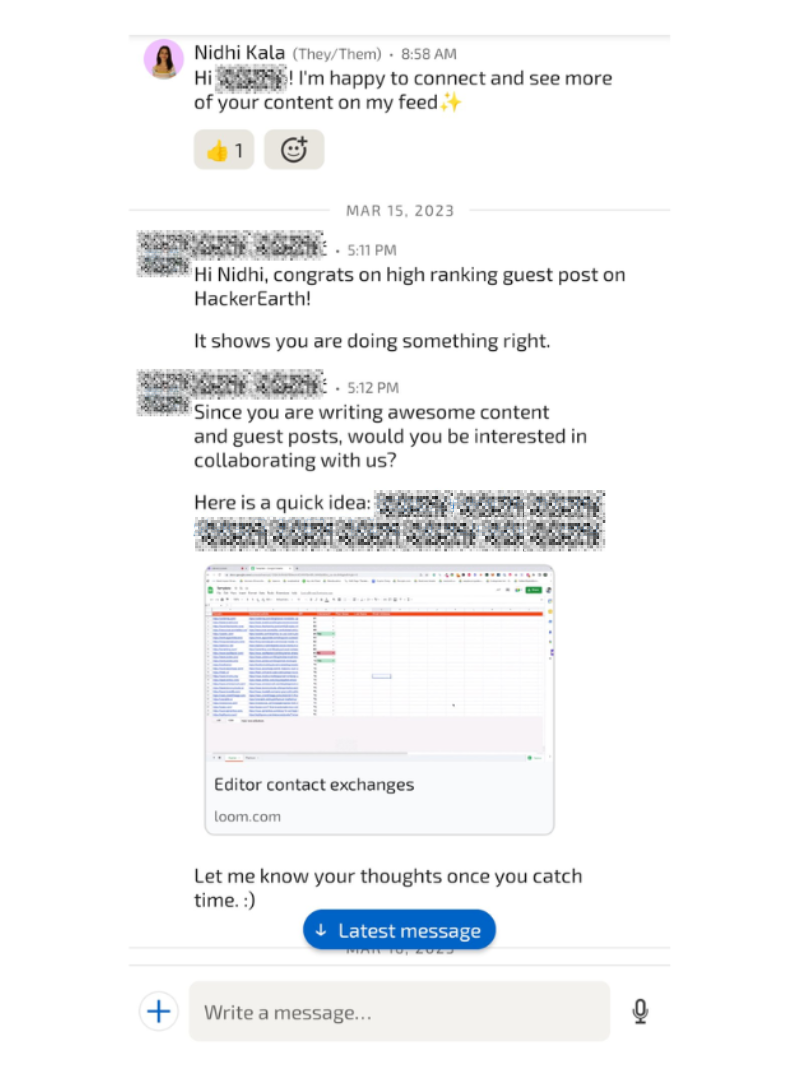
3. Find common ground to personalize your message
A common mistake when sending DMs is not personalizing your message. First impressions count — don’t waste them by copying and pasting the same message to ten different people. If you want your DM to get opened and replied to, include some personal details.
Marco Palma, Chief Marketing Officer at PR Lab, says it’s best to do your research to find common ground before reaching out. “Maybe we share an alma mater, or they've written an article I admired. Mentioning these connections grabs their attention and shows I'm not just sending a cookie-cutter message.”
If you’re battling to find a sincere point of connection between you and your recipient, there are plenty of other ways to tailor your message so it doesn’t come across as spammy or impersonal. We’ll get into some ways to do this below.
4. Show that you understand and respect their work
In her DM outreach, Fractional Content Manager Lily Ugbaja lives by the mantra: “Be human, be worthy.” See the receiver as another person, not just someone to get something from, she says.
As Macro touched on above, genuinely complimenting your recipient’s work or content is another way to lay a strong foundation.
Here’s an example of how you can start a conversation simply by saying what you liked about a particular post.
"I was talking to [contact] the other day about optimizing the engagement process, and he was kind enough to direct me to your gem of a thread," the sender wrote, also sharing a link to the particular thread.
"Just wanted to reach out and show my appreciation for saving me a ton of time — thanks!"
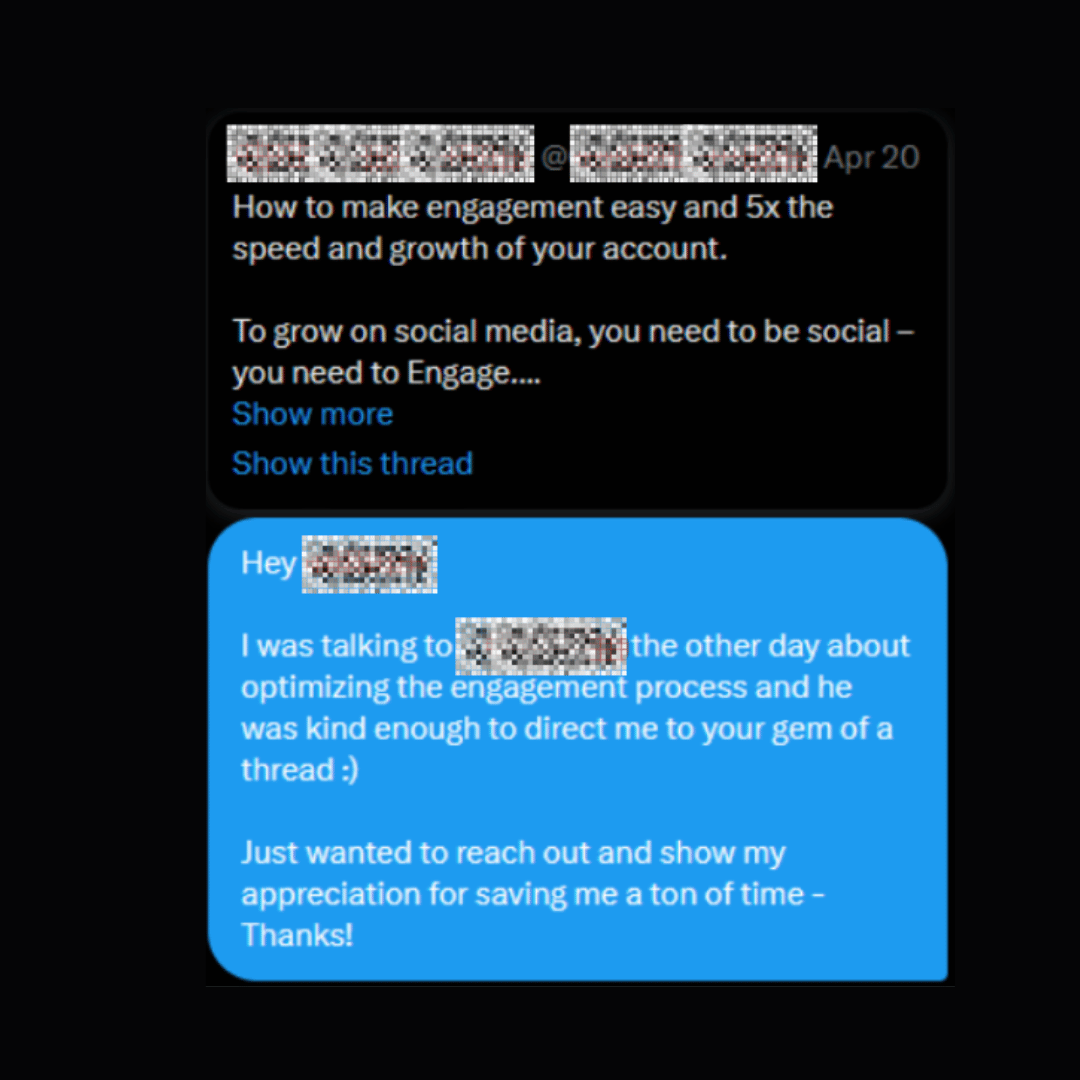
Expressing interest in the recipient's work or acknowledging specific accomplishments demonstrates that your outreach is well-informed and sincere. Here’s another example from Rochi Zalani (who you may have seen before on the Buffer blog).
"I hope your week is going well so far," Rochi wrote. " I just wanted to say a huge congrats for your growth at [link]. I've been eyeing [company] for a while, and I'm not at all surprised at how you've grown it."
"If you're ever looking for contributors for your blog, I'd love to be considered! I write for B2B Saas, and the type of content is totally my jam."
"It's always nice to 'meet' a fellow content person on the internet. Stay in touch and have a great day ahead."

Notice how Rochi acknowledged the recipient's expertise and accomplishments. She also kept her language relaxed and relatable (you'll have to gauge whether this is appropriate for your recipient). Her timing was great, too!
This thoughtful approach not only establishes rapport but also establishes a sense of mutual respect between both parties. The ask, framed within the context of a collaborative opportunity, becomes a natural progression of the conversation rather than an abrupt request.
5. Offer value before you ask for it
A powerful way to build trust is to offer value upfront. There are many ways to do this — you could send a resource, connect them with a valuable contact, give actionable advice on an issue they publicly talked about, or provide something else that you think could be useful to them.
For instance, I noticed a fellow freelancer’s newsletter had a potential area for improvement with their CTA (call-to-action). I DMed them about it, offered some thoughts for a solution, and shared some sources should they want to do their own research.
You might not see your effort reciprocated immediately, but people appreciate the gesture and may return the favor in the future. Building relationships isn’t always immediately transactional but rather about offering support and helping when you have the bandwidth.
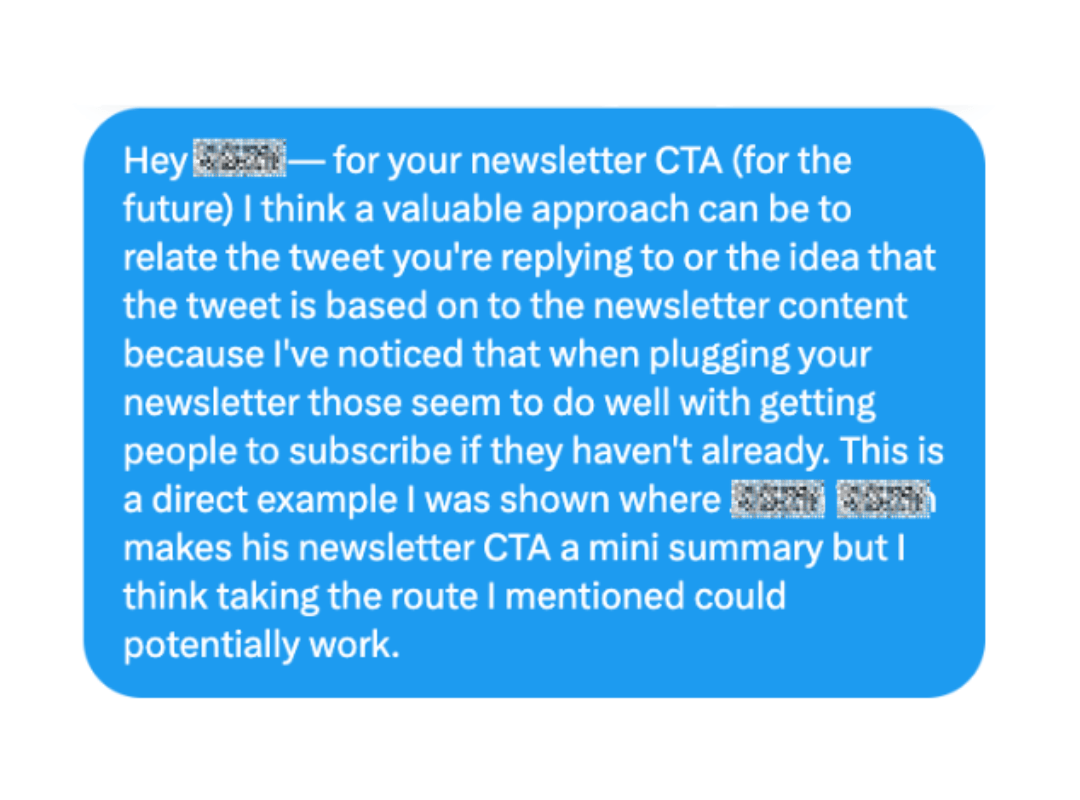
6. Lean into mutual connections
If there’s a specific person you’re looking to connect with, explore their network to see if you have any connections in common.
“If you're not yet in the right position to get someone’s attention, draw a web, not a straight line,” Lily says. In other words, who's someone accessible to you who's connected to your target? Reach out to them first to get into your target recipient's circle.
Here’s an example of how she did it — notice how she took the conversation beyond the ask, hoping to deepen her relationship with her connection:
"Thank you for engaging with my recent post," Lily wrote. I remember [contact] referred me to some at the [company] team for ghostwriting last year so I was excited to see your name come up."
"I just checked out your Twitter, and you hate bananas. Can I ask why? I'm really curious."
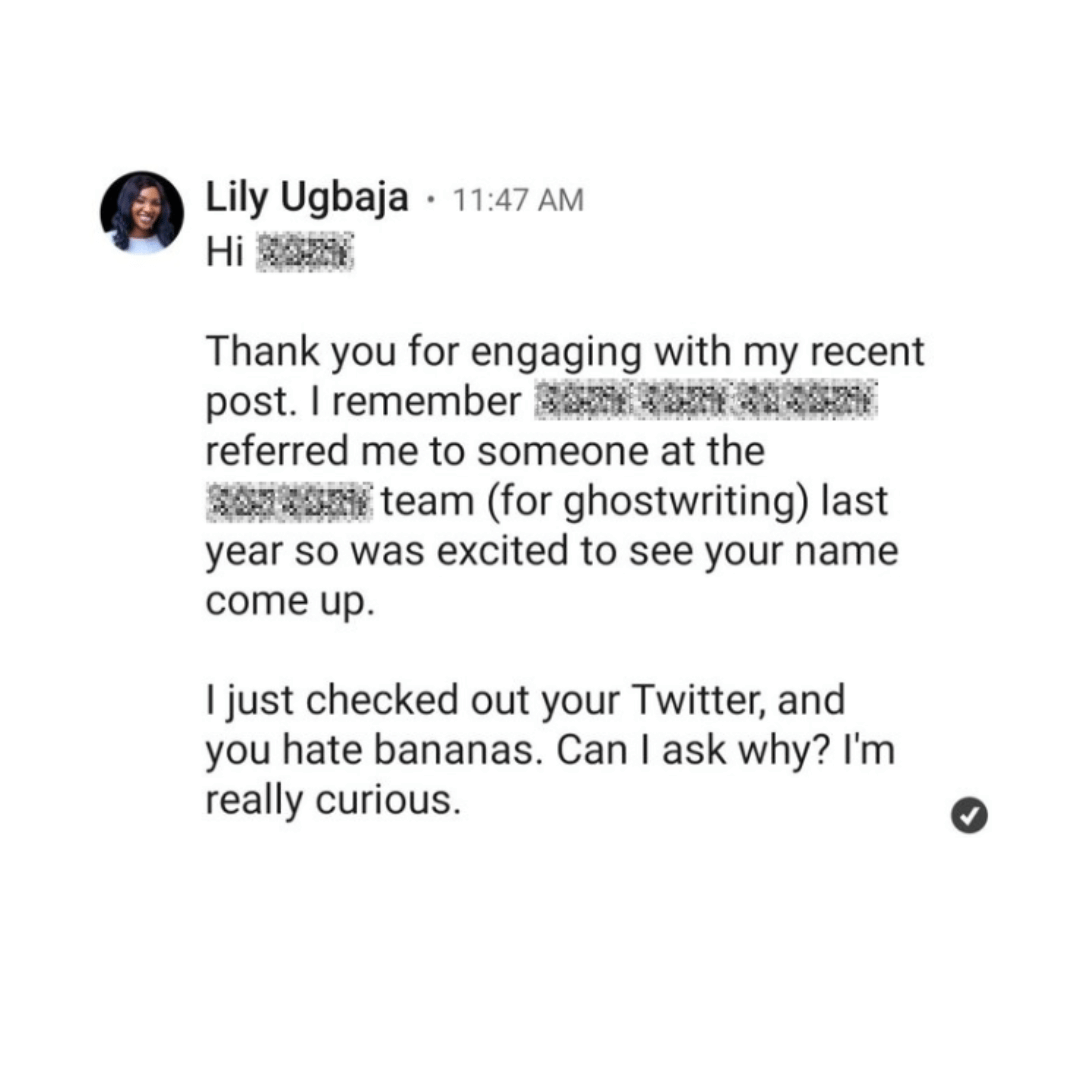
7. Go beyond social media
When cultivating relationships, don’t feel limited to social media. Ben Regier, Community Marketing Lead at Commsor, doesn’t play hard to get.
“When I find something in common with someone, or they're looking to solve a problem I can help with, I go straight to the DMs to show the person I want to be intentional about the relationship,” he says. “From there, I see the DM as a springboard to ask to get on a virtual coffee, exchange phone numbers, or even meet in person.”
Going deeper than the initial interaction creates relationships that are more likely to lead to collaborations on future projects, referrals, and a network of contacts.
8. Know when to make your request
Fostering connections in DMs can be beneficial all on its own — you never know how a great contact might be able to help you or vice versa.
But in many cases, you’ll reach out with a specific request in mind. Perhaps, like my freelance peers, you’re looking for new clients or customers. Maybe you’d like to work with your recipient’s company, to appear on their podcast, or to collaborate on another piece of content. Whatever you’d like their help with, there are two ways to approach making this request:
- Focus on cultivating the relationship first by leveraging the tactics above. Then, once you’ve acquainted yourself and feel comfortable enough, you can make an ask.
- Include the ask in your initial message, along with some of the tactics on this list.
There’s no right or wrong way to do this; it might require experimentation to see which route works best for you. My preference is to be transparent. Here’s an example of a message I’d send (with plenty of personalization).
“Hey [name],
I hope this message finds you well.
I recently came across your post about [topic], and the insights you shared [takeaway you had from their content — make sure this is thoughtful and personal].
I’m curious to know what projects you’re currently working on or if you have anything in development at the moment.
Thank you for your time,
[Your name]”
This achieves two things: you get the conversation rolling, and you can also see if there is anything that you can possibly help them with.
You want to have an idea of their current needs and goals, as well as any problems they’re currently dealing with.
This step may require several more questions to present an opportunity to offer value but keep the conversation going by asking relevant questions in that direction.
Here’s another example of a well-executed networking DM that is transparent but upfront. Note how the sender provides social proof by mentioning clients he’s previously worked with to add weight to his expertise.
"Was just checking out the link in your bio and saw loads of value there, including some lead magnets. Do you currently have a welcome sequence for those magnets? I'm finishing one now for [contact] and [contact] and am able to take on a couple more clients this month."
"I don't want to waste your time and only want to work with businesses that genuinely need the help. If creating an email sequence is of any interest to you, Id be more than happy to help. Appreciate your time!"
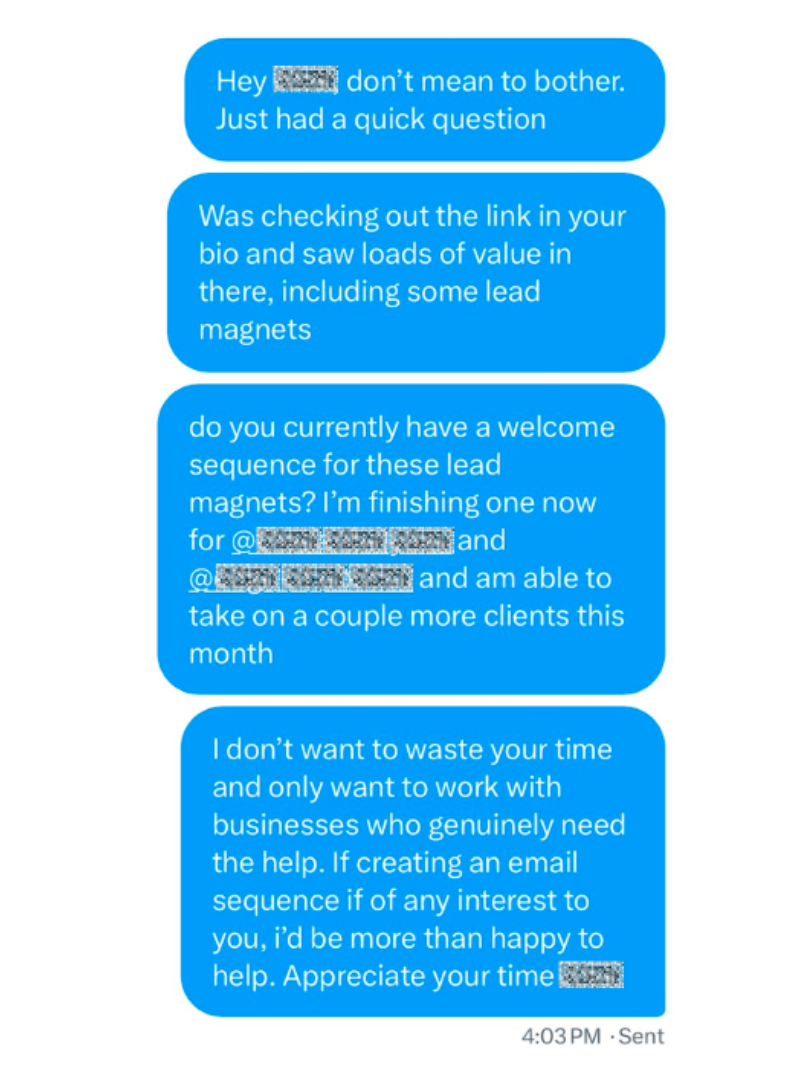
9. Sometimes, brief is best
While most DMs will call for starting a conversation first, some simply require a brief message to get the job done.
If you’re responding to a job listing, you only need to introduce yourself with relevant information, like what industry you specialize in, clients you’ve worked with, and what you have to offer.
Some platforms like LinkedIn require the person you’re trying to message to accept your connection request before your first DM. The platform does allow you to send a character-limited note with connection requests, which is handy, but you’ll have to be concise.
Here's a sample connection request note:
"Hello [name]! I'm a freelance writer in the SaaS space. I've written for companies like Clearscope, LinkedIn, Uber, Shopify, and more. Connecting because I'm enjoying [company] blog. If you're ever in need of another writer, I'd love to chat. Thanks!"

10. Know when to follow up
Knowing when and how to follow up tactfully is critical if your recipient doesn’t reply immediately.
According to Rochi, it’s important to “space out your follow-up DMs with a minimum of seven days between messages.”
When following up, reference your initial message or ask if they’ve had a chance to read it. This serves as a gentle reminder and demonstrates that you're genuinely interested in continuing the conversation and value their input.
“You can talk about their latest post in a line or two to keep it relevant, but get to the point fast,” she says. “Remember, the goal is to make them notice your first message.”
Use DMs intentionally
While direct messages have a reputation for being impersonal, they can be a great tool when you put the other person first and have real conversations.
Knowing who you’re messaging, when to make your request, and how to follow up tactfully can help you build genuine relationships online and open doors to new opportunities.
I wouldn’t have the network or freelance friends I do today without DMs, which have connected me with amazing people from all over the world.
And remember: networking is not just limited to social media; don't hesitate to take the conversation off the platform for a more meaningful connection.
Try Buffer for free
140,000+ small businesses like yours use Buffer to build their brand on social media every month
Get started nowRelated Articles

TikTok's parent company must divest the app or face a ban in the U.S. Here's everything we know, plus how to plan ahead.

Whether you’re a full-time content creator, micro-influencer, nano-influencer, or just getting started, here’s how to create your own influencer media kit.

In this article, get answers to questions about social media for solopreneurs.